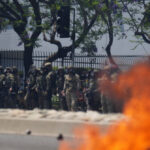
Idaho prosecutors have unveiled a college essay from student murders suspect Bryan Kohberger that shows he knows his way around a crime scene, new court filings reveal.
In the missive, written in 2020 during finals for a 300-level criminal justice course, Kohberger described how crime scene investigators use “fiber-free” overalls, gloves and booties to avoid contaminating the location with their own DNA and fingerprints.
At 1122 King Road, where he allegedly killed four University of Idaho undergrads in November 2022, police have revealed little evidence aside from a Ka-Bar knife sheath found under one of the victims that allegedly had Kohberger’s DNA on the snap. Before the FBI identified him as a person of interest through investigative genetic genealogy, his name was unknown to detectives.
IDAHO WEATHER FROM NIGHT OF STUDENT MURDERS CLOUDS ‘MOON AND STARS’ ALIBI
He went into other aspects of a crime scene investigation, but repeatedly referenced measures police should take to protect the location, shared his thoughts about circumstantial evidence, identified domestic partners as potential suspects and warned that crime scenes could be staged.
BRYAN KOHBERGER’S FAMILY COULD BE ASKED TO TESTIFY AGAINST HIM: COURT DOCS
“Prosecutors are going to talk about this when they bring up the lack of forensic evidence left by the killer,” said Joseph Giacalone, a former NYPD cold case investigator and a criminal justice professor at Penn State-Lehigh Valley.
“They’re going to say, ‘Look how much he knew about this. He talks about fiber-free clothing.’”
Kohberger mentioned fiber-free overalls, shoe covers, gloves, hair nets and more when talking about protective gear an investigator should wear to avoid contaminating a scene.
“This is not helpful for him,” Giacalone said.
“The same way he talks about this fictitious cop about not leaving evidence behind…we might have a little insight into how, or at least an answer about, the lack of forensic evidence was left behind,” Giacalone told Fox News Digital. “He doesn’t mention it by name, but Locard’s Exchange Principle, the theory of transfer between all evidence, he does talk about transfer of evidence a number of times throughout this.”
But Kohberger also made some mistakes in the piece, Giacalone said.
SIGN UP TO GET TRUE CRIME NEWSLETTER
“He said staging is common,” Giacalone told Fox News Digital. “It’s not common. You know, most of the things that happen at crime scenes are mistakes or just panic mode.”
He also doesn’t believe that Kohberger, if he committed the crimes as alleged, would have had time to stage the scene after killing four people in roughly 15 minutes, then running into an eyewitness on the way out, who he did not attack.
FOLLOW THE FOX TRUE CRIME TEAM ON X
“I think there’s no way that he didn’t see her,” he said. “So the staging part of this, I don’t find it plausible for him in that scenario.”
Kohberger, who, through his attorneys, has argued there was blood and DNA evidence at the victims’ home that could point to potential alternate perpetrators, wrote in his essay that crime scene investigators don’t have the responsibility of vetting potentially planted evidence.
GET REAL-TIME UPDATES DIRECTLY ON THE TRUE CRIME HUB
“Even if there was an item introduced to the scene by an offender to throw off investigators, it is not the job of the criminal investigator processing the crime scene to jump to conclusion,” Kohberger wrote.
Giacalone said if Kohberger turned in the paper for one of his classes, he’d probably give it a B.
“He knows a lot, but you can get this out of any academic book,” Giacalone said. “You can learn about this, but putting it into practice and doing it are two other things.”
Read Bryan Kohberger’s essay
Kohberger graduated from DeSales University with a master’s degree and then went on to Washington State University to pursue a Ph.D. in criminology. The school is just 10 miles away from the University of Idaho, where he is accused of entering a house at 4 a.m. and killing four of the six students inside on Nov. 13, 2022.
The victims were Madison Mogen, 21, Kaylee Goncalves, 21, Xana Kernodle, 20, and Ethan Chapin, 20. The three young women were all roommates. Chapin lived nearby and was dating Kernodle.
Kohberger’s trial on four charges of first-degree murder and another of burglary is set to begin on Aug. 11. Jury selection is scheduled for July 30.
A previous judge entered not-guilty pleas on Kohberger’s behalf at an arraignment in May 2023. He could face the death penalty if convicted.






